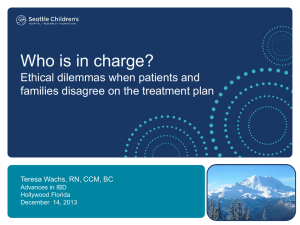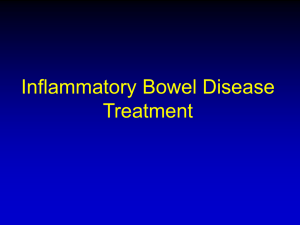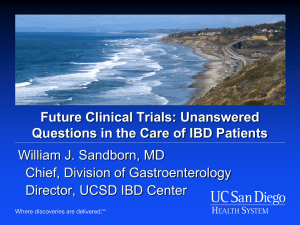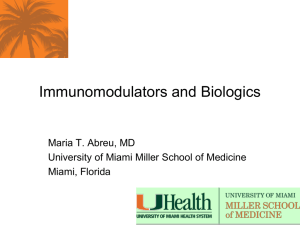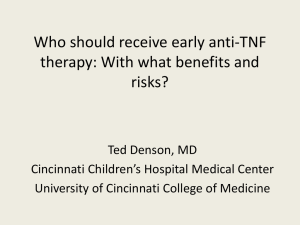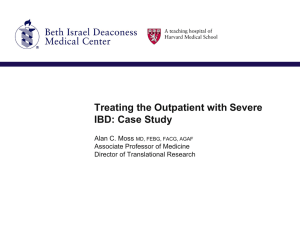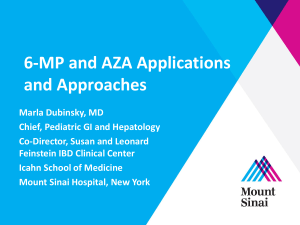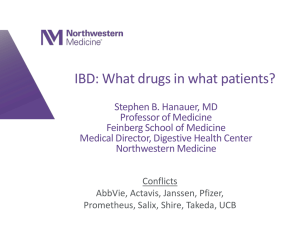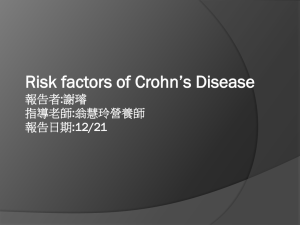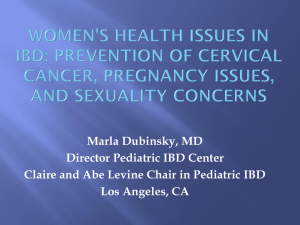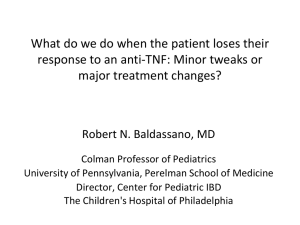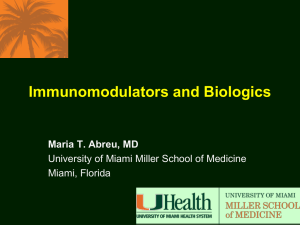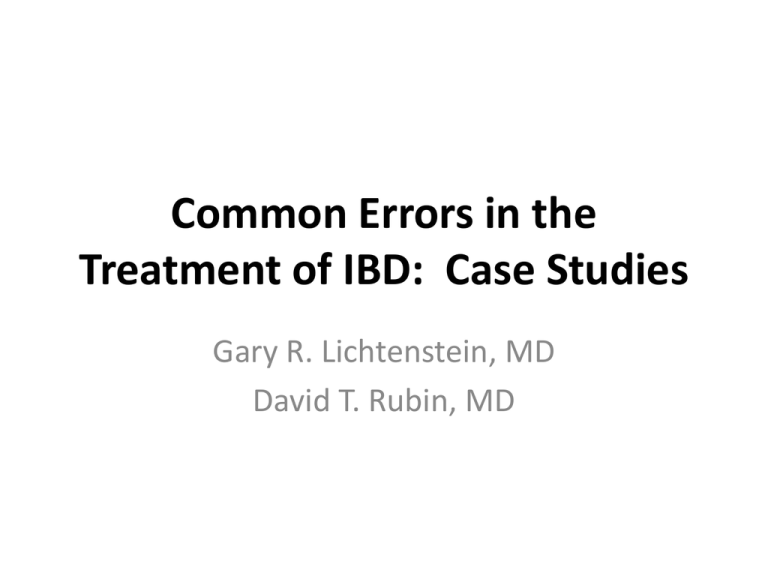
Common Errors in the
Treatment of IBD: Case Studies
Gary R. Lichtenstein, MD
David T. Rubin, MD
Gary Lichtenstein, MD
Disclosures
Research, Advisory, and/or Honorarium
• Abbott
• Alaven
• Bristol-Myers
Squibb
• Elan
• Ferring
• Hospira
• Meda
• Luitpold /
American
Regent
• Millenium
• Ono
• Pfizer
• Prometheus
• Salix
• Santarus
• ScheringPlough
• Shire
• Takeda
• UCB
• Warner Chilcott
Some Common Errors in IBD Management
1.
2.
3.
4.
5.
Delay in diagnosis! This is not usually a gastroenterologist’s error.
Steroids as initial therapy for mild to moderate UC- trust the
evidence!
Using anti-TNF therapy as mono therapy- concomitant is favored
for most patients at least for induction.
Avoiding surgery when it is needed.
Under dosing therapies:
– 5-ASA – focus on delivery
– Thiopurines – understand metabolism and shunters
– TNF – in some patients (maybe less than we would like to think)
6.
7.
8.
Not vaccinating
Ignoring vitamin D
Relying on “crisis management” rather than proactive monitoring
and control
9. Dismissing patient interests in diet or complementary therapies
rather than working with them
10. Not referring to mental health professionals
Why Do Patients With IBD Not Respond To
Their Medications?
Primary Nonresponse
Secondary Nonresponse
•
•
•
•
•
•
•
•
Drug/mechanism just doesn’t work
Wrong diagnosis
– Infection
– Ischemia
– Crohn’s disease
Wrong dose
– Not enough
– Too much?
– pK issues
Wrong delivery
– Rationale
Allergy/intolerance
•
•
Change in dose (by you)
Change in delivery
Change in physiology
– Does disease change
over time?
Intentional nonadherence
– Episodic dosing strategy
– Denial
– Fear of therapy
Unintentional nonadherence
– Can’t afford medication
– Inconvenient dosing regimen
Patient Case 1
Diagnostic Evaluation
• Female, age 23 yr;
well until 5 mo ago
• Symptoms
– Pain
– Diarrhea (4–6 loose
stools/day)
– 5-lb weight loss
• Physical examination
– Tender RLQ
– No mass
• Social History
– Cigs: 1ppd x 5 yrs
CRP = C-reactive protein; RLQ = right lower quadrant.
• Laboratory values
–
–
–
–
WBC: 4,500 cells/µL
Hgb: 10.5 g/dL
CRP: 5.5 mg/dL
Albumin: 3.5 g/dL
• Colonoscopy
– Terminal ileum and cecum
with numerous aphthous
ulcerations
– Biopsies c/w Crohn’s
• SBFT
– Mild bowel-wall thickening
with slight narrowing in
terminal ileum only
Initial Treatment
• Diagnosis
– Mild-to-moderate ileocecal CD
• Treatment goals
– Induce rapid, complete remission
– Minimize the potential for side effects
• Treatment prescribed
– Mesalamine 1.2 g TID
• Response
– No clinical improvement after 3 weeks
Mesalamine is not FDA approved for the treatment of Crohn’s disease in the United States.
Induction Nonresponder
• What is the most appropriate treatment option in this
patient ?
1. Continue mesalamine at a higher dose
2. Change to another 5-ASA derivative
3. Add a systemic corticosteroid –prednisone 40 mg
orally daily
4. Switch to EC budesonide at 9 mg a day
Treatment Options for Mild Moderate Crohn’s Disease
Sequential Therapies for Crohn’s Disease
Disease Severity
at Presentation
Natalizumab
Anti-TNF
Severe
Corticosteroid
Anti-TNF+/Thiopurine/MTX
Thiopurine/MTX
Moderate
Aminosalicylate
Budesonide
Mild
Aminosalicylate
Budesonide/Thiopurine
Induction
Maintenance
Step-Up according to severity at presentation or failure at prior step
Conventional CD Therapy is
Sequential
Mild
Moderate
Aminosalicylates
Antibiotics
Locally Active Oral
Corticosteroids
Oral
Corticosteroids
Antimetabolites
(AZA,6-MP, MTX)
Severe
TNF antagonists
(IFX, ADA, CZP)
Parental
Corticosteroids
Bowel Rest
Natalizumab
Surgery
Treatment of IBD
I. Establish the Correct Diagnosis, Severity of
Disease & Extent of Disease
Ulcerative Colitis versus Crohn’s Disease
Disease Distribution
Severity of Disease
ACG Guidelines
Determining Severity of Crohn’s Disease
Mild to
Moderate
Ambulatory without toxicity, no
abdominal tenderness, painful mass, or obstruction
Moderate
to Severe
Unresponsive to treatment for mild-to-moderate
stage or with prominent fever, weight loss, anemia,
abdominal pain and tenderness, or intermittent
nausea or vomiting
Severe to
Fulminant
Persistent symptoms on corticosteroids or with high
fever, rebound tenderness, cachexia, or abscess
Asymptomatic, no inflammatory sequelae,
responsive to medication or surgery, or not
Remission
requiring systemic corticosteroids
Lichtenstein GR, Hanauer SB, Sandborn WJ. Am J Gastroenterol . 2009; 104(2):465-83 .
Mesalamine Delivery Systems
Sulfasalazine
Olsalazine
COOH
(Azulfidine)
(Dipentum)
NHSO2
N
N
N=N
5-ASA
CH
5-ASA
N=N
5-ASA
Sulfapyridine
Mesalamine
Mesalamine
Mesalamine
Controlled-release Capsules Delayed-release Capsules
(Pentasa)
(Asacol)
Rectal suspension
enema / suppository
Gastro-resistant/pH (Rowasa, Canasa)
(Lialda)
Mesalamine
Balsalazide Disodium
Capsules
(Colazal)
5-ASA
5-ASA
5-ASA
5-ASA
Ethylcellulose
Microspheres
Eudragit S/L
Mesalamine
Granulated formulation
(Apriso)
NaOOC
MMX technology
5-ASA
(ABA)
inert
carrier
OH
NCCDS: Response to Therapy for
Active Crohn’s Disease
70
60
50
Sulfasalazine 1 g/15 kg (5 g)
Patients 40
(%)
30
13%
20
Placebo
10
0
0
5
10
15
Weeks after Randomization
NCCDS, National Cooperative Crohn’s Disease Study.
Summers RW et al. Gastroenterology 1979;77:847-869
Meta-Analysis: Mesalamine
in Active Crohn’s Disease
Change from baseline in CDAI score
Pentasa® 4 g
Pentasa® 4 g minus Placebo
Placebo
0
0
-10
-10
P=0.7
-20
P=0.5
-20
-30
P=0.04
-30
-40
-50
-40
P=0.7
-60
-50
-70
-80
P=0.04
P=0.005
-60
P=0.05
Crohn's I Crohn’s II Crohn's III Overall
n=155
n=150
n=310
n=615
P=0.005
Crohn's I Crohn's II Crohn's III
n=155
Hanauer, Stromberg. Clinical Gastroenterology & Hepatology 2004
n=150
n=310
Overall
n=615
Role of Antibiotics in Crohn’s
Disease
• Widespread use despite insufficient evidence
– Inadequate data for metronidazole and
ciprofloxacin as first-line therapy
• May be useful in the management of
– Complications
– Perianal disease
– Small Intestinal Bacterial Overgrowth
– Postoperative prophylaxis
• Little, if any, effect on small bowel disease
• Potential for resistance and selective overgrowth
and Clostridium Difficile infection
Corticosteroid Therapy for
Crohn’s Disease
Immediate
Outcome*
(n = 74)
Complete
Remission
58%
(n = 43)
Partial
Remission
26%
(n = 19)
No
Response
16%
(n = 12)
1-Year
Outcome
(n = 74)
Prolonged
Response
32%
(n = 24)
Steroid
Dependent
28%
(n = 21)
Surgery
38%
(n = 28)
*30 days after initiating corticosteroid therapy.
Faubion W, et al. Gastroenterology. 2001;121:225-260.
Budesonide in Active Ileal/
Right Colonic Crohn’s Disease
Budesonide CIR 9 mg
Mesalamine* 4 g
Prednisolone 40 mg
Placebo
Patients in Remission (%)
80
70
60
66%
53%
62%
51%
50
36%
40
30
20%
20
10
0
10 Weeks1
8 Weeks2
CIR = controlled ileal release. *Mesalamine controlled-release capsules (Pentasa).
1. Rutgeerts P, et al. N Engl J Med. 1994;331:842-845. 2. Greenberg GR, et al. N Engl J Med.
1994;331:836-841. 3. Thomsen OO, et al. N Engl J Med. 1998;339:370-374.
16 Weeks3
Corticosteroids in Crohn’s disease
• Budesonide is first-line therapy for mildmoderate ileal or right colon disease
– Maintenance therapy?
• Systemic steroids for moderate-severe disease
• High risk of steroid-dependence
• Greatest risk of long-term side effects
– AGA Quality guidance
• Attempt steroid weaning
• Monitor for osteoporosis
Change of Therapy
• Treatment
– EC budesonide 9 mg QD for 8 weeks
• Outcome
– Remission attained at 5 weeks
– Hgb: 11.2 g/dL
– Mild facial acne
– EC Budesonide successfully tapered to complete
cessation after 8 weeks
• Plan
– Watchful waiting
Followup
• Followup
– 2 weeks after cessation of EC Budesonide
symptomatic recurrence is noted
– 6 BM / day with RLQ abdominal pain
– Perianal drainage from a small fistula was noted
• Labs:
– WBC- 13.0 x 109 / L
– Hgb: 8.7 g/dL
– ESR- 45 mm/hr
– CRP - 22 mg/L
Recommendations
• Which of the following are appropriate at this time
1.)
2.)
3.)
4.)
5.)
6.)
MRI enterography
CT enterography
Stool for C diff
Ask patient to stop smoking
1 and 4
1, 3 and 4
Refractory IBD
• Establish the Correct Diagnosis, Severity
of Disease & Extent of Disease
• Evaluate for Disease Complications
• Evaluate for Enteric Infections
• Use Optimal Medication Doses
• Miscellaneous
•
•
•
•
NonAdherence
Paradoxical Responses
NSAIDs
Cigarettes
Disease Complications
Abdominal / Pelvic Abscess
CT abdomen and pelvis with oral and iv
contrast
MRI pelvis with gadolinium
Mesenteric Venous Thrombosis
CT abdomen and pelvis with oral and iv
contrast
MRI pelvis with gadolinium
Enteric Infections
Bacterial Infections
CMV
Clostridium Difficile
Parasitic Diseases
“Pseudointractibility” of IBD
•
•
•
•
CMV
Clostridium Difficile
NSAIDs
Cigarette
• Cessation in UC
• Use in CD
MRI Enterography: Active Crohn’s Disease
T2 and Post-gad images demonstrating marked thickening and enhancement of TI.
Note elevated T2 signal within and adjacent to TI (arrows) indicating active disease.
Followup
• Followup
– Therapy was initiated with infliximab 5 mg /kg at 0,2,
and 6 weeks the every 8 weeks and also AZA 2.5
mg/kg was given (TPMT enzyme activity was
normal).
– Oral Iron was given (Ferritin checked was 10 ng/mL).
– Within a period of 3 months symptomatic remission
was noted.
– Hgb - 11.0 grams
– WBC- 9.9 g/dL
– ESR- 12 mm/hr
– CRP - 3.8 mg/L
CASE 2: The Patient Failing
Thiopurine Therapy
Two Brothers with Ulcerative Colitis
• Patient #1: 18 yo with pancolitis, steroid responsive but
steroid dependent.
– TPMT normal
– 6-MP started at 1.5 mg/kg
– Unable to wean steroids below 15 mg
• Patient #2: 15 yo brother of patient #1, ulcerative proctitis,
steroid resistant
– TPMT normal
– 6-MP started at 1.5 mg/kg
– Not responding
Metabolism of Azathioprine
and 6-Mercaptopurine
6-Methylmercaptopurine
TPMT
HPRT
Azathioprine
6-Mercaptopurine
XO
6-Thiouric
acid
Chan GL et al. J Clin Pharmacol. 1990;30:358.
Thioinosinic
acid
6-Thioguainine
nucleotides
Association Between Clinical Response and
Both 6-TGN and Intermediate Activity TPMT Genotype in
Pediatric Patients With IBD
Therapeutic Efficacy
6-TG Quartiles
Frequency of 6-TG level >235
(pmol/8 × 108 RBC) (%)
78%
100
80
41%
60
40
20
n=44
n=42
n=43
n=44
0
0–173
174–235
236–367
368–1,203
Dubinsky MC et al. Gastroenterology 2000;118:705.
Frequency of 6-TG level
Frequency of Response
Frequency of response
(pmol/8 × 108 RBC) (%)
100
80
65
60
40
27
20
0
Response
Failure
The Patient not Responding to Thiopurine
• Confirm adherence, consider metabolites:
6-TG
6-MMP
undetectable
undetectable
Dubinsky. Curr Gastroenterol Rep. 2003;5(6):506-11.
Possible cause
Non-adherent
or
underdosed
Recommendation
Understand why pt not
taking med or
increase dose
The Patient not Responding to Thiopurine
• Confirm adherence, consider metabolites:
6-TG
6-MMP
undetectable
undetectable
Non-adherent
or
underdosed
Understand why pt not
taking med or
increase dose
Low (<230)
Low or
undetectable
Non-adherent or
underdosed
Discuss adherence,
increase dose
Dubinsky. Curr Gastroenterol Rep. 2003;5(6):506-11.
Possible cause
Recommendation
The Patient not Responding to Thiopurine
• Confirm adherence, consider metabolites:
6-TG
6-MMP
undetectable
undetectable
Non-adherent
or
underdosed
Understand why pt not
taking med or
increase dose
Low (<230)
Low or
undetectable
Non-adherent or
underdosed
Discuss adherence,
increase dose
Low (<230)
High (>5700)
6-MMP shunter
1. Increase thiopurine,
or
2. Consider allopurinol,
or
3. Switch agents
Dubinsky. Curr Gastroenterol Rep. 2003;5(6):506-11.
Possible cause
Recommendation
The Patient not Responding to Thiopurine
• Confirm adherence, consider metabolites:
6-TG
6-MMP
undetectable
undetectable
Non-adherent
or
underdosed
Understand why pt not
taking med or
increase dose
Low (<230)
Low or
undetectable
Non-adherent or
underdosed
Discuss adherence,
increase dose
Low (<230)
High (>5700)
6-MMP shunter
1. Increase thiopurine,
or
2. Consider allopurinol,
or
3. Switch agents
“Therapeutic”
(>230-<400) or
High (>400)
Normal range or
high
Primary nonresponder
1. Assess disease
2. Switch to different
mechanism
Dubinsky. Curr Gastroenterol Rep. 2003;5(6):506-11.
Possible cause
Recommendation
Brothers with Shunting
6-MP monotherapy
Pt
TPMT
6-TGN 6-MMP ALT
1
23.0
137
13,477 114
2
19.7
301
12,796 141
The Patient not Responding to Thiopurine
• Confirm adherence, consider metabolites:
6-TG
6-MMP
undetectable
undetectable
Non-adherent
or
underdosed
Understand why pt not
taking med or
increase dose
Low (<230)
Low or
undetectable
Non-adherent or
underdosed
Discuss adherence,
increase dose
Low (<230)
High (>5700)
6-MMP shunter
1. Increase thiopurine,
or
2. Consider allopurinol,
or
3. Switch agents
“Therapeutic”
(>230-<400) or
High (>400)
Normal range or
high
Primary nonresponder
1. Assess disease
2. Switch to different
mechanism
Dubinsky. Curr Gastroenterol Rep. 2003;5(6):506-11.
Possible cause
Recommendation
Practical Approach to Allopurinol and
Thiopurine Combination Therapy
• Not for everyone! Be aware of safety concerns.
• Choose patient (and MD) wisely:
–
–
–
–
•
•
•
•
•
•
Active disease
Adherence with thiopurines
Subtherapeutic 6-TGn, supratherapeutic 6-MMP
Elevated LFTs or nausea may be present but not necessary
to consider this approach
Drop thiopurine to 25 mg (6-MP) or 50 mg (AZA)
Allopurinol 100 mg
Notify pharmacist!
CBC weekly for one month, then monthly…
Metabolites at week 3
Dose adjustment if necessary but in small increments
Govani and Higgins. J Crohns Colitis 2010;4(4):444-9.
Sparrow, et al. J Crohns Colitis 2009;3(3):162-7.
Brothers with Shunting
6-MP monotherapy
6-TGN 6-MMP ALT
6-MP/allopurinol
Pt
TPMT
6-TGN 6-MMP ALT
1
23.0
137
13,477 114
422
--
21
2
19.7
301
12,796 141
351
--
25
Both patients responded quickly (within 2-3 weeks), have been in
stable steroid-free remission for >2 years.
Case 3
• 21 year old male with a 4 year history of
extensive small bowel CD treated with
infliximab for the past 3 years presents with
increasing cramping abdominal pain, 12
pound weight loss and diarrhea
• No recent travel or antibiotics
• No previous abdominal surgery
• SH: Does not smoke
• FH: No FH of IBD
• On infliximab 10mg/kg q 6 wk
Case 3
• PE shows a well appearing male in NAD with fullness in
the RLQ
• Stool samples for enteric pathogens and C. diff
negative
• MRE- 5cm segment of small bowel disease with small
bowel dilation proximal to the area of involvement but
w/o inflammation
• IFX level (trough: 9.0 mcg/ml)
• ATI negative
• LABS:
WBC – 8.6 K
Hgb – 12
Ptlt- 334 K
CRP- 3.3 (Normal < 4 mg/dl)
Case 3
Please choose the best management strategy
1. Increase infliximab
2. Add an antimetabolite (AZA/6MP/MTX) and
continue infliximab
3. Switch to adalimumab or certolizumab
4. Switch to natalizumab
5. Continue infliximab but evaluate for small
bowel intestinal overgrowth, irritable bowel
syndrome and consider surgical options
6. Send for ileocecectomy
Factors that Influence the PK of
TNF Antagonists
Impact on TNF antagonist PK
Presence of ADAs
Decreases drug concentration
Increases clearance
Worse clinical outcomes
Concomitant use of
immunosuppressives
Reduces ADA formation
Increases drug concentration
Decreases drug clearance
Better clinical outcomes
Low serum albumin concentration
Increases drug clearance
Worse clinical outcome
High baseline CRP concentration
Increase drug clearance
High baseline TNF concentration
May decrease drug concentration by
increasing clearance
High body size
May increase drug clearance
Sex
Males have higher clearance
ENT06169 10/07
Ordas I et. al. Clin Gastroenterol Hepatol. 2012; 10:1079-1087.
Aim
Clinical Outcomes of Patients With Detectable
Human Anti-Chimeric Antibodies or
Subtherapeutic IFX Concentrations
• Examine the utility of measuring HACA and IFX concentrations and
compare subsequent clinical management and response
Detectable HACA
Subtherapeutic
concentrations
Response to test
Complete/partial
response (%)
P value
Increase IFX
1/6 (17)
<0.004
Change anti-TNF
11/12 (92)
Increase IFX
25/29 (86)
Change anti-TNF
2/6 (33)
<0.016
HACA and IFX concentration testing impacted treatment decisions in
73% of patients and were a useful adjunct to clinical and
endoscopic/radiologic assessment
ENT06169 10/07
Afif W, et al. Am J Gastroenterol. 2010; 105:1133-1139.
Followup: Case 3
•
•
•
•
Therapeutic infliximab trough level
(7 μg/mL) and short segment of fixed noninflammatory disease
Send to surgery and laparoscopic
ileocecectomy performed
Treated postop with metronidazole 500mg
po bid for 3 months as well as 6MP
Doing well 10 months postop with
colonoscopy demonstrating 2 isolated
aphthous erosions in the neoterminal ileum
Drug Levels Predict Immunogenicity:
Serum IFX at Week 4 After an Infusion Predicts Eventual
Appearance of ATI’s in Episodic Dosing
Week 4 serum level and
subsequent ATI titre
P = ns
P<0.001
P<0.001
• “an IFX level of <4 μg/ml
measured 4 weeks after the first
infusion had a PPV of 81% to
detect the development of high
ATIs during the later course of
treatment”
• “an IFX level of >15 μg/ml
measured 4 weeks after the first
infusion was 80% predictive for
the absence of ATIs during later
follow-up.”
“Therefore, IFX levels measured early after the first infusion of IFX (at 4 weeks)
are a good prognostic parameter for development of immunogenicity.”
Vermeire et al. Gut 2007;56;1226-1231
Patients With Sustained ATI Associated With LOR
Patients who discontinued IFX
treatment due to
LOR/hypersensitivity (%)
P<0.001
Vande Casteele N, et al. Am J Gastroenterol. 2013. DOI:10.1038/ajg.2013.12.
Time to IFX Discontinuation Due to LOR
Patients who discontinued IFX
treatment due to
LOR/hypersensitivity (%)
Transient ATI (n=12)
Sustained ATI (n=35)
Log-rank P=0.006
Years of IFX follow-up
Vande Casteele N, et al. Am J Gastroenterol. 2013. DOI:10.1038/ajg.2013.12.
AAA Formation Lowers Adalimumab Trough Serum
Levels
• 92% of the patients with a trough serum concentration measured below
the threshold for detection were positive for AAA
Median ADA TR
(μg/mL)
8.9
(n=53)
10
8
2
0
8.8
(n=37)
6.1
(n=58)
6
4
AAA (+)
AAA (-)
11.1
(n=46)
12
2.1
(n=9)
5.8
(n=30)
0.6
(n=8)
Week 4
Week 12
0.1
(n=8)
0.02
(n=3)
Week 24
Week 54
0.05
(n=10)
Therapy
Discontinuation
Reprinted from Gastroenterology 137(5), Karminis K, et al. Influence of trough
serum levels and immunogenicity on long-term outcome of adalimumab therapy in
Crohn's disease, 1628-1640. Copyright 2009, with permission the AGA Institute.
Proposed Treatment Algorithm in the Setting of Loss
of Response
High titers
High
Clearance
Switch within
class
Low titers
Impact
Clearance
Drug escalation
or switch
High titers
High
Clearance
Switch
Low titers
Impact
Clearance
Drug escalation
or switch
ADAs
LOR
Negative &
ADAs (+)
Drug
Positive
Subtherapeutic
Drug escalation
Therapeutic
Change drug
class
(no benefit from
dose
escalation)
Subtherapeutic
& normal CRP
De-escalation
Ordas I et. al. Clin Gastroenterol Hepatol. 2012; 10:1079-1087.
Can Antibodies to Biologic Therapies Be Overcome?
• 5 patients with loss of response to infliximab,
undetectable infliximab trough levels, and
positive antibodies to infliximab on 2 occasions
• Antimetabolite therapy added without changing
dose of infliximab
– Methotrexate (2); Thiopurine (3)
• ATI titer decreased and trough IFX levels rose
over 1-5 months
• Clinical response reestablished
Ben-Horin S. CGH 2013;11:444-7
Conclusion
• Reactive Therapeutic Drug Monitoring effective for
optimization of AntiTNF therapy in NonResponders
• Most data studied with Infliximab- but likely applies to
other antiTNF agents
– Adalimumab
– Certolizumab Pegol
• Future prospective trial needed to define Proactive Drug
monitoring
CASE 4
• 24 year old woman with newly diagnosed
Crohn’s disease of the colon, ileum and
perianal skin tags with a small simple
fistula
– Anemic
– Elevated CRP
• Treated with infliximab and azathioprine
• Excellent response and clinical remission
• Laboratory values return to normal
CASE 4 - continued
• After 6 months of continuous therapy,
requests to stop azathioprine
• 6 weeks later, has blood per rectum, loose
stools
• Steroids started
• Infliximab given early at higher dose
• No improvement
CASE 4 - continued
• What happened here?
• Colonoscopy performed:
– complete mucosal healing
– Small irritated skin tag with friability
– Fistula not draining
CASE 4 – continued - oops
• 4 months later
• Diarrhea, frank hematochezia
– Anemic
– CRP elevated again
• C. diff negative
• Therapeutic assessment
– Infliximab level elevated (16 ug/ml)
– No antibodies to infliximab
Interpretation of Infliximab Levels and Antibodies to
Infliximab in a Patient Losing Response
Elevated
Antibodies to
Infliximab
Absent
Elevated
Present
Not elevated
Absent
Not elevated
Present
Infliximab Level
Treatment
recommendation
Switch treatment
mechanism
Unclear, consider
switching to another
TNF-inhibitor
Adjust dose, interval of
infliximab
Switch to another
TNF-inhibitor
Afif, et al. Am J Gastroenterol. 2010 ;105(5):1133-9.
Switching Between TNF Inhibitors:
Rheumatoid Arthritis Experience
• Response to a second inhibitor is lower relative to
first 1
• Response to a second inhibitor will be comparable if
initial discontinuation was due to adverse events 1, 2
• Patients who do not respond to 2 TNF inhibitors are
not likely to respond to a third 2
1.
2.
Gomez-Reino et al. Arthritis Research & Therapy. 2006;8:R29
Solau-Gervais et al. Rheumatology. 2006;epub ahead of print.
Non-Anti-TNF Mechanisms of Management for
the Patient Failing anti-TNF Therapy
Confirm Inflammation First
Crohn’s Disease
• Natalizumab
• Methotrexate
• Surgery
Ulcerative Colitis
• Cyclosporine
• Tacrolimus
• Surgery
– Including staged
approaches or diversion for
induction of remission
• Bowel rest
• Less evidence:
– Mycophenolate
– Tacrolimus
Don’t Forget
about Clinical
Trials!
Leukocyte
Trafficking
Inhibition
leukocyte
Brain
Bone marrow
Gut
a4b1
integrins
a 4b 7
natalizumab
natalizumab
Vedolizumab, rhuMab-beta7
PF-00547659
addressins
VCAM-1
MadCAM-1
endothelium
Updated Utilization and Safety Results of
Natalizumab in CD and MS
(TOUCH, CD INFORM, TYGRIS & Pregnancy Registry Studies)
• 118,100 patients have received globally (postmarketing) as of 6/30/2013
– Predominantly MS patients
• PML (Progressive Multifocal Leukoencephalopathy)
– Rare but serious – 410 cases reported globally as of 01-Oct2013; 23% have died
– Longer duration and prior immunosuppressant use increases
risk
– Risk for patients treated 24-36 months similar to rates seen in
clinical trials
– Limited safety data beyond 4 yrs of treatment
– No known treatment or prevention interventions for PML
https://medinfo.elan.com (accessed 12-Dec-2011); PML Incidence according to Elan Pharmaceuticals at 04Nov-2013.
Recommendations for JCV Antibody Testing
• Testing prior to treatment with natalizumab
• If positive, consider retesting.
– If confirmed, option is treatment with natalizumab for 9-12
months
• If negative, may treat with natalizumab, retest every 6 months
– If converts to positive, stop therapy
• The benefit and safety of a drug holiday and restarting after
“resetting” the exposure has not been tested in Crohn’s
disease
• Vedolizumab (expected approval Q2 2014) does not have
PML associated with it.
CASE 4 - conclusion
•
•
•
•
•
JCV antibody negative
TOUCH program
Natalizumab initiated (300 mg IV q month)
Stable remission returns
Ongoing monitoring
– Repeat JCV antibody assessment q6 months
What happens to the patients who receive
natalizumab in the current post-TNF paradigm?
Chicago Experience
Sakuraba et al. Inflamm Bowel Dis 2013; ;19(3):621-6.
SUMMARY: Avoiding Errors in IBD
• Clarify diagnosis and the presence of
inflammation when making treatment
adjustments
• “Optimize” therapy – delivery, metabolism
and pK
• Rule out confounders
• Don’t stay within class if the mechanism
has clearly failed
• Remember surgery

